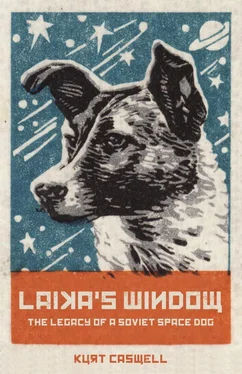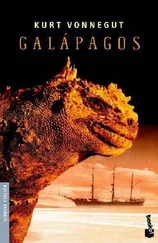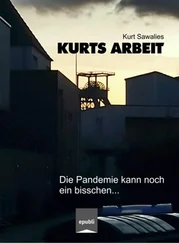1. the conditions of near-Earth orbit, which includes the absence of oxygen, meteorites that might damage a spacecraft and its crew, cosmic and solar radiation, and extreme temperatures both hot and cold
2. spaceflight itself, which includes acceleration and the resulting g-forces, vibration, weightlessness, and noise
3. confinement in a small spacecraft, which includes isolation; bodily functions, especially eating, drinking, and elimination of waste; and psychological stresses
Soviet rockets in the early stages of development could not carry the heavy payloads of today, so space dogs had to be small, between thirteen and sixteen pounds. They had to be relatively young, between eighteen months and six years. And they had to be white, mostly white, or another suitably light color. A black-and-white video camera was installed in many of the spacecraft to gather visual data during flight, and white dogs were much easier to see in this footage. Finally, the dogs had to be female. A primary reason for this was waste collection. Flight suits were fitted with a waste collection system that functioned best when both solid and liquid waste exited the dog from the same basic location of the body. There was no equipment or room in a flight capsule allowing a male dog to lift his leg. Even so, a number of the sources I read refer to some of the space dogs as “him” or “he,” and some were given names more suitable for male dogs. A Russian friend and translator explained to me that in Russian one would always refer to a dog with a male name as “he,” regardless of its sex. So those dogs were female with male names, or some were in fact male. Indeed, a few sources report that a few male dogs did fly but only on suborbital flights. Other sources avoid using pronouns for the dogs altogether, preferring their names, possibly to avoid inaccuracies regarding sex.
When evaluating temperament, the dogs were sorted into three categories: even-tempered, anxious or restless, and inactive. Even-tempered dogs were generally the most successful in the training program, but a restless dog might become more even-tempered, or an inactive dog might come alive when given a job to do and a routine to do it in. The dogs eventually identified as suitable for flight were later sorted into rocket dogs qualified for short-duration suborbital flight and satellite dogs qualified for long-duration orbital flight.
Most of these small white female dogs were acquired at shelters in Moscow or directly from the city streets. “I went around with a tape measure and some tasty morsels,” said biologist Ludmilla Radkevich in the documentary Space Dogs . “For several days I drove around in a military car with a military driver through the outskirts of Moscow. If we saw a little dog running along, I’d jump out, measure it, and if it was small enough, pop it in the car. We collected about sixty dogs that way.”
The team preferred mixed-breed dogs, primarily for their hardiness. “We did not choose purebred dogs for the flights as they lacked the required resilience to the flight loads,” Yazdovsky said in Space Dogs . “Instead we picked mongrels which were more accustomed to extreme living conditions.” If a dog was alive and well on Moscow’s city streets, the thinking went, it could endure cold and other challenging weather conditions and isolation, and go without food for long periods of time. The streets of Moscow turned out to be the perfect environment for the making of a space dog.
The dogs’ health was primary to the success of their training and flight program and to the science, so important that Korolev himself made daily visits to the kennels to check on the dogs and on their caregivers’ efficiency and attention. He did not tolerate sloppy work. He loved the dogs and often picked them up and whirled them around in his arms. It was often overly warm inside the kennels, and the soldiers guarding the dogs were tasked with keeping their water bowls filled. As Korolev made his rounds one day, he found a few of the bowls empty. “Let’s get someone in here who cares about dogs,” he reportedly said, and sent the offending soldier to the brig. “It’s hard to believe that someone could love our dogs so much,” medical doctor Alexander Seryapin said in Space Dogs . “First thing every morning, [Korolev] went not to his office but to visit the dogs. He would check the temperature of their water. If the water was warm, he would give the lab technicians hell. ‘Why is their water warm? What have they been fed today?’ And every day after work without fail, [Korolev] dropped in to see how the dogs were doing.”
Once selected, training helped the dogs cope with the conditions of flight. While the dogs were not volunteers, a great deal of care was taken to put only the dogs that completed the training into rockets. The dogs trained to endure confinement for long periods of time (up to twenty days for long-duration flights), the noise and vibration of rocket flight, and a high-g environment followed by microgravity. The noise and vibration could be simulated by a vibration table. The dogs in training were secured to this table, Burgess and Dubbs write, and “the hapless animal would be shaken about, while the mechanism of the table created a loud and obviously frightening banging.” Sensors recorded blood pressure and heart rate, which rose dramatically during the vibration and noise but then returned to normal after the test. The g-force of rocket flight was simulated in a centrifuge, which spun the dogs in a circle on the end of a mechanical arm. While the acceleration of liquid-fueled rockets tops out at about 5g, the training pushed the dogs to a maximum of 10g. In a high-g environment, blood moves away from the brain, which can result in a loss of vision and consciousness. Even today, pilots and astronauts train in such centrifuges to build tolerance and familiarity with high g-force.
¤
Sputnik II was a cone-shaped satellite sitting on top of a modified R-7 rocket, the world’s first ICBM. The satellite consisted of three main components, stacked one on top of the other. On top was a small cylindrical instrument package with two spectrophotometers for measuring solar radiation, especially in the ultraviolet and X-ray regions of the spectrum, as well as cosmic radiation. In the middle was a spherical container that had been built as a backup for Sputnik I , containing batteries, radio transmitters, and other instruments. And on the bottom, Laika, inside a cylindrical pressurized capsule with its small round window. When completed, Sputnik II measured 13 feet long and 7 feet wide at its base and weighed 1,120 pounds, six times heavier than Sputnik I .
Laika’s capsule was made of aluminum alloy and measured 31.5 inches long by 25 inches in diameter, not very big at all, but then she wasn’t a very big dog. In his book Korolev , James Harford remarks that the capsule was not built specifically for Laika; rather, the team modified the capsule that housed Dezik and Tsygan on the first suborbital space dog flight in 1951. Inside the capsule Laika was positioned on a cork floor with sides coming up above her, a slot, really, just her size. Restraints limited her movement and secured her during the rocket’s ascent and in orbit, and helped ensure that she did not tear loose from the sensors attached to her body. Despite these restrictions, Laika could lie down comfortably, sit hunched over, and move forward and backward, but she could not turn around.
The small round window made the capsule look as if it had an eye, and it was sometimes called a “Cyclops chamber.” A crate or kennel used to transport or confine dogs is similarly designed, and when inside, a dog will almost always face the door, the end where the most light enters, not unlike a wolf in its den. It makes sense that a denning animal like a dog would fare much better on an extended spaceflight than a monkey or a chimp evolved to live in forests and forest canopies and on open scrublands. These considerations must have driven the design and installation of the window, but the primary purpose had to be observation from the outside. The caregivers and scientists used the window to monitor Laika during training and preflight preparations. During flight, the window was of use only to the dog. Some sources speak of a video camera mounted inside Laika’s capsule, but they are surely in error. In all my searching, I could find no photographs or video footage of Laika, either during liftoff or in orbit. The ground crew had no way to visually monitor her after they secured the protective fairing over the nose cone of the rocket.
Читать дальше












